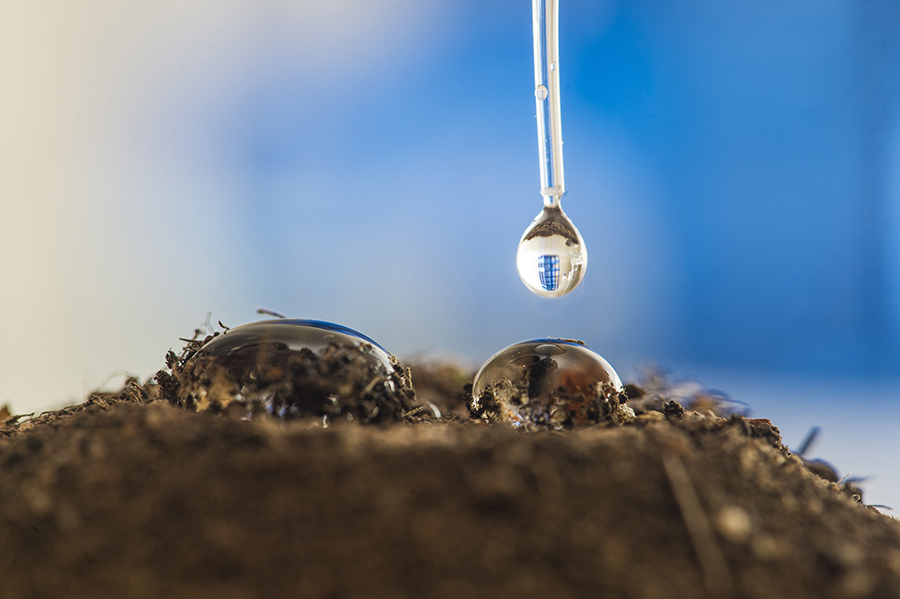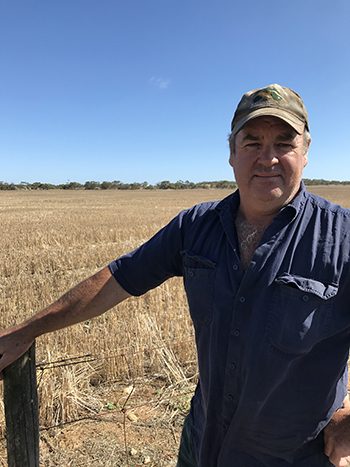A road trip taken by Karkoo grower Scott Crettenden and some of his neighbours in 1995 provided the impetus to ameliorate their sandy soils and, ultimately, their production potential for the next 25 years or more.
The trip was an 800-kilometre excursion from South Australia’s central Eyre Peninsula to Keith in the state’s south-east to attend a field day where clay spreading using a land plane implement to ameliorate non-wetting sands was being demonstrated.
Clay spreading remediates the non-wetting characteristics of sandy soils caused by waxes from decaying organic matter. Non-wetting leads to patchy soil moisture infiltration, uneven crop emergence and growth, low yields and increased risk of wind erosion.
The field day showed that incorporation of subsoil clay was an effective treatment, which increased water infiltration and moisture-holding capacity in the soil surface layer and boosted crop yields significantly.
The excursion prompted the troop of district growers, including Scott, to arrange for a land plane to spread clay across several of their Karkoo properties later that year. But these early attempts at claying had limited success.
Scott says the layer of clay applied using a land plane at high rates – about 250 tonnes a hectare – proved too thick and it was not incorporated into the sand effectively. This resulted in surface sealing, with moisture becoming trapped in the thick clay layer in the top 20 to 30 centimetres of the soil.
The consequence was shallow root architecture and vigorous early season growth which caused crops to “cave in” during the grain-filling phase, he says.
In the mid 1990s, there were few alternatives for applying clay aside from land plane-spreaders. The main options were heavy earthmoving equipment, such as road scrapers that applied clay at rates of 100 to 250t/ha, or fertiliser spreaders that applied less than 30t/ha.
Growers needed a prescriptive approach using a machine that could apply clay at flexible rates depending on the thickness of the sandy topsoil. This led Scott to explore the potential of a prototype ‘Claymate’ machine, which was developed specifically for clay spreading in 1991 by SA grower Noel Fisher.
In 1997, Scott purchased one of these tractor-towed units designed to sequentially rip the clay, pick it up and then spread it on 10-metre-wide strips at controlled rates.
His plans for the Claymate were modest: “I was initially aiming to spread clay on my own farm and maybe a few neighbours’ farms to pay off the machine.”
Unexpected business

Clay spreading remediates the non-wetting characteristics of sandy soils caused by waxes from decaying organic matter. Photo: Evan Collis
However, Scott soon found himself operating the machine as a busy contracting business, driven by overwhelming grower demand for clay spreading on the Eyre Peninsula.
“Demand for the Claymate machine exploded,” Scott says. “We were inundated with calls and jobs were booked two years in advance.
We spread clay nearly every hour of every day – from a month before harvest until seeding – for the next seven years.”
During this time, Scott estimates that the contracting business spread clay on about 12,000ha of water-repellent sands. “We modified a lot of the non-wetting sand areas on the central-lower Eyre Peninsula.”
Over this vast geographic area, from Cleve in the north to Edillilie in the south, the business worked with a highly variable mix of clays and sands.
For instance, the Edillilie area is characterised by buckshot clays, containing eroded remnants of marine sediments, while the Kapinnie area features a hard sand layer over clay. Soil composition was also highly variable, with clay and sand occurring in undulating layers of different thickness, or the two soils occurring in parallel bands throughout the profile.
Such diverse soils needed to be matched by different clay application rates ranging from 50t/ha to 150t/ha.
Customised approach

Scott spread clay across all the non-wetting sands on his own paddocks at Karkoo, South Australia, while running the contracting venture. Photo: Julie Crettenden
Scott says the optimal claying rate was often 100t/ha. But rates as low as 50t/ha effectively ameliorated shallow surface layers of non-wetting sand about 10 centimetres deep. Conversely, high rates were required to amend deep sand layers. Rates above 150t/ha were difficult to incorporate.
He says logistics were critical to the efficiency of the business which worked simultaneously on several farms in the same district. Once the clay pits were opened, the moist clay usually needed to dry out for one to two weeks before being spread.
While a pit was drying out the machine moved onto other nearby jobs before returning to spread the dried clay.
“One of the secrets to effective clay spreading was allowing it to dry out so the clay cracked and crumbled into fine particles that could be spread and incorporated more evenly.
“To spread clay on a 20ha area, for example, we might dig three or four pits, and rotate the Claymate between different pits set up for multiple jobs on nearby farms while the pits dried out.”
Where feasible, Scott generally aimed to position the clay pits in the centre of the area that required spreading to optimise operational efficiency.
“We would move from district to district, typically working on five or six farms in one area.”
For each pit, a bulldozer was used to remove the topsoil to expose the clay. The pits were usually about 30m long and 15m wide, but only about 50 to 100cm deep.
Beyond this soil depth, the clay quality was usually compromised by limestone rubble prone to interfering with soil pH.
“The bulldozer would then rip the top layer of clay to help it dry out quicker."
Once the clay had dried, it took less than a minute to load 8t of clay into the Claymate, which was then unloaded in strips across the paddock’s sandy surface as the machine was towed behind a tractor.
Following spreading, the clay was incorporated into the topsoil by growers using tyne and rolling implements, such as a cultivator with harrows and a stone-roller, to break up clods and effectively incorporate the clay.
“Any clod of clay bigger than a pinhead isn’t suitable – it has to be crumbled into a fine dust for effective incorporation,” he says. Scott encouraged growers to leave the clay to naturally weather on the soil surface until late March before incorporating it.
Tricks of the trade

Scott says the soil amelioration benefits of clay spreading have persisted on his Karkoo property for more than 20 years. Photo: Julie Crettenden
An important lesson learned from years of soil amelioration over such a wide area was to tackle shallow areas of non-wetting sands before deeper areas.
“Growers naturally wanted to target their worst, deep non-wetting sand areas first, and then gradually ameliorate their better, shallow non-wetting sands. However, it was better value to focus on the shallow areas because they required lower clay rates and we could ameliorate much larger areas faster.”
He says the total cost of the amelioration earthworks, including digging the pits and spreading the clay, in the late 1990s and early 2000s was about $250/ha. However, the returns are ongoing due to the long-term benefits of clay amelioration, such as the soil’s improved moisture-holding capacity, nutrient retention and organic matter content.
He says the characteristics of the clayed sandy soils are improved and paddocks treated in the 1990s are still showing benefits more than 20 years later.
Scott managed to spread clay across all the non-wetting sands on his own family farm while running the contracting venture. But his father’s retirement and Scott's acquisition of a new leased property provided the catalyst to eventually sell the business in 2003.
Clear production driver 20 years on
 Scott used the Claymate machine to spread clay on 800ha of his own properties near Karkoo, SA, between 1997 and 2003. Photo: Julie Crettenden
Scott used the Claymate machine to spread clay on 800ha of his own properties near Karkoo, SA, between 1997 and 2003. Photo: Julie Crettenden
Scott says clay spreading on his own farm to ameliorate non-wetting sands has transformed the sandy soil quality, and in turn, the productivity of his cropping program.
He implemented clay spreading, targeting water-repellent sands, on his family’s 3075ha-property in the Karkoo district on SA’s central Eyre Peninsula in the late 1990s.
Clay was used to modify about 800ha of non-wetting sands from 1997 to 2003. “About 50 per cent of most paddocks had non-wetting sands that required clay applications,” Scott says.
He says the amelioration program has provided a range of cropping benefits in the 20 years since it was implemented.
In the past two years, these improvements have been brought into sharper focus by the family’s acquisition of leased farmland. The new untreated paddocks have allowed the Crettendens to compare crop performance on clayed and unclayed sandy country.
“Applied clay has arrested water being funnelled down through the non-wetting sand into the underlying clay layer,” he says. “Instead, surface sands are better able to retain water where it lands following the clay incorporation.”
Scott says the improved moisture-holding capacity of clayed sands has the potential to provide a four-fold increase in wheat yields – from about one to four t/ha.
The yield lift on the Crettenden farm mainly stems from the crop's ability to access more moisture in the surface soil, he says. Also contributing are two important side-effects of the increased plant-available water – improved crop germination and reduced weed pressure.
Prior to the clay works, for example, crops planted on non-wetting sands tended to germinate about a month after seeding. Germination was also patchy and infested with grass weeds, Scott says.
But the applied clay has led to faster, more-uniform crop germination on sandy soils. It has also promoted earlier germination of grass weeds, particularly brome grass, which can be controlled with knockdown herbicide applications before crop emergence. “Brome grass has disappeared from previously infested sandy areas,” he says.
Other benefits of clay amelioration are increased crop density, growth and stubble loads that help protect sandy soils from wind erosion, especially in dry seasons.
Claying has also expanded the family’s cropping options. For instance, they can grow wheat instead of barley on sandy soils.
Before claying, the low water-holding capacity of their non-wetting sands meant crops were susceptible to moisture stress late in the season. They were limited to growing barley on sands in the past because it could better compete with weeds compared with wheat, Scott says.
More information: Scott Crettenden, 0427 767 024, jcretty@telstra.com

























































